Meet the Veggie Snob
I was born and raised in the suburbs of Washington, D.C. You could say I was a city girl. When it came to vegetables I was used to eating ones from a can or a frozen white box. It wasn’t until I married my husband of almost 20 years that I got a taste of the good stuff—by that I mean fresh vegetables, cooked to perfection by my mother-in-law, June Beasley.
I often tease June and call her a “vegetable snob” because she really has an affinity for vegetables. I never knew the complexity of vegetables until I learned from her. We are in the midst of the season for fresh fruits and vegetables, and I thought, what better time to learn from the master and share her tips with the readers of Southport Magazine. This is her story, as told to me.

June Beasley, Southport’s resident ‘veggie snob,’ stands in the fields of the family farm she grew up on in Loris, South Carolina. Photo by Kris Beasley
“Born and raised on a tobacco farm in Horry County, South Carolina, summer was not my favorite time of the year. When school was over, instead of going to the beach and having fun, many days I was up at 3 a.m. to unload a barn of cured tobacco, and soon as that was done, to reload that same barn with green tobacco. It was hot, nasty work.
“The thing I remember with pleasure from those hot days was dinner on the farm. The main feature of those dinners ([eaten at] 12 noon) was fresh vegetables from the garden. Speckled butter beans, Dixie Lee field peas, fried okra, corn, sliced cantaloupe, tomatoes and cucumbers.
“Meat was not the star of the meal. Usually we did have pork chops or fried chicken. Sometimes the only meat we had was fat back or streak o’ lean, which was fried to render the lard to season the vegetables. We always ate the fat back. Nothing was thrown away. We had corn bread, biscuits and rice. But the meal was planned around the vegetables.
“Having a garden so close to the house enabled my mother to be particular about picking the vegetables at their peak—not when they were biggest but when flavor was at its peak. I still use her rules when shopping for vegetables today. Those days were hard, but I’m glad I lived during those times. It taught a family of five children what hard work is, how to appreciate what you have, and to have a good work ethic.”

1. Speckled Butter Beans (gray in color, similar to green butter bean/lima bean. As they mature they speckle.)
Where to buy: Roadside produce markets or farms
What to look for: Buy them already shelled, light gray in color and the ideal size is the tip of your pinky finger
Don’t buy if: Most of the beans are speckled and bigger than the end of your thumb (I know this doesn’t make sense, but it is the way it is.)
Best way to cook: Cover beans with water in a medium size pot. Sprinkle with salt and add one teaspoon to one tablespoon of oil (canola, vegetable or peanut). You can add a strip of bacon if want. Bring to a boil and cover. Simmer for about 20 minutes. You know the beans are done when the larger beans are soft. Do not overcook or the beans will be mushy and dark.

2. Yellow Squash
Where to buy: Grocery stores and roadside produce markets or farms
What to look for: Pale yellow in color. No bigger than the size of your hand, from the bottom of your palm to the tip of your middle finger.
Don’t buy if: Dark yellow, skin is warty, bigger than your hand. Bigger is not better.
Best way to cook: Slice squash crosswise into 1/4-inch medallions. Slice an onion in rings. Use a big skillet, and over medium heat, melt one stick of butter or 1/4-cup of olive oil. Add all the squash and onions. Sprinkle to taste with salt and pepper. Cover and cook for roughly 20 minutes until the squash is fork tender. You should stir several times during the 20 minutes.
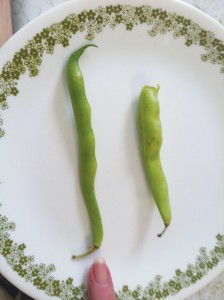
3. Green Beans
Where to buy: Grocery stores and roadside produce markets or farms
What to look for: Bright green in color. Length does not matter. What you want is a slim bean, no bigger than the diameter of your pinky. Green beans tend to lighten as they age.
Don’t buy if: The diameter is bigger than your pointer finger and their color is pale, light green. Or the tips are shriveled and brown.
Best way to cook: Place the clean beans in a pot. Cover with chicken broth or water. Salt to taste. If you use water, pour one tablespoon of oil (any kind of oil will do). Cover and bring to a boil. Reduce heat and simmer for 45 minutes to an hour.
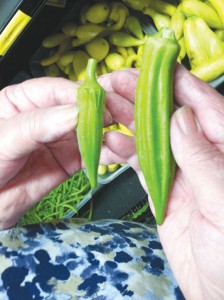
4. Okra
Where to buy: Grocery stores and roadside produce markets or farms
What to look for: Small pods, no bigger than three inches; two inches is optimum. Bigger is not better.
Don’t buy if: They are longer than three inches and you cannot pierce the skin with your fingernail. Big okra will be tough.
Best way to cook: Slice each pod into 1/4-1/2 inch chucks. Discard the top and tip of okra. Okra is slimy, so use a sharp knife. Heat a large non-stick pan (non-stick is best as okra can stick easily) over medium heat. Add three tablespoons of oil (any kind of oil will work). Add okra to the pan. Salt to taste. Sprinkle lightly with some cornmeal to absorb the slime (optional). Cook for 5 minutes and then stir carefully. It will be gooey at first but it will go away. You will need to cook for roughly 20 to 30 minutes, stirring often to keep the okra from burning. Adjust your heat and add oil if it begins to really stick to the bottom of the pan. You will know it is done when each chunk is soft the edges are browned.
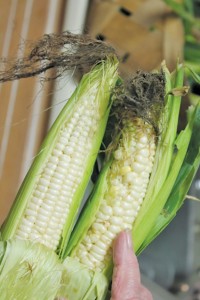
5. Corn (yellow, white or tri color; no real difference in taste)
Where to buy: Grocery stores and roadside produce markets or farms
What to look for: Peel back the husk to view the kernels. They should be well formed and in even rows. Be sure that they kernels on the tip are smaller. If they are the same size as the ones below, it will be tough.
Don’t buy if: The kernels or rows are not uniform. If there are missing kernels.
How to cook: Shuck corn and remove silks. Fill large pot with water. Put 1/4 cup of sugar in the water. Bring to a boil. Put corn in boiling water and cook for 7 minutes and remove pot from the heat. Do not overcook. Drain corn and serve with butter, salt and pepper.
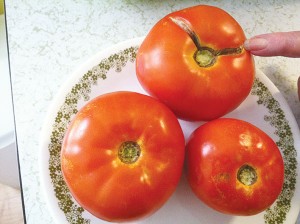
6. Tomatoes
Where to buy: Roadside produce markets or farms
What to look for: Bigger is better. Uniformed red color.
Don’t buy if: Soft or dark spots. The skin is split.
How to prepare: Slice and eat fresh with salt and pepper.

7. Cucumbers
Where to buy: Grocery stores and roadside produce markets or farms
What to look for: No longer than six to seven inches. Dark green in color. With a diameter of no more than three inches. Smaller is best.
Don’t buy if: Pale in color or yellowish green. Longer than eight inches. Thicker than three inches. Wrinkled or soft or flexible.
How to prepare: Peel, slice in medallions and sprinkle with salt or place in a bowl and add cider vinegar.
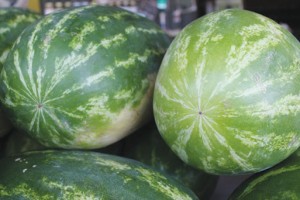
8. Watermelon
Where to buy: Grocery stores and roadside produce markets or farms
What to look for: Dark colors. Stripes closer together. A yellow or light bottom.
Don’t buy if: The stem is green. Has an irregular shape.
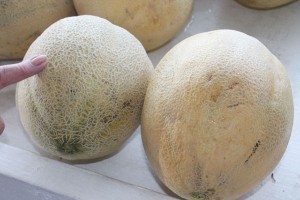
9. Cantaloupe
Where to buy: Grocery stores and roadside produce markets or farms
What to look for: Consistent yellow hue. Strong melon scent.
Don’t buy if: Green hue and webbing is prevalent. No smell.











Enjoyed this article so much! Brought back so many memories of my childhood. I was raised the same way as your mother in law. My grandmother would throw out all of the beans that were speckled. I do the same thing when I put up beans. People not born in the south don’t understand why they are called speckled butter beans but yet we don’t eat them if they. They should be called grey butter beans!